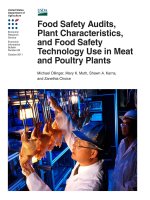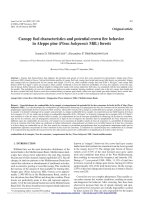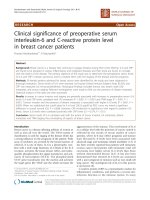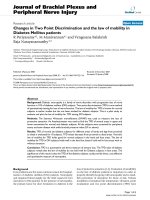Clinical, histological characteristics and SFRP2, RNF180 methylation status in gastric carcinoma patients experienced surgical resection at 103 military hospital
Bạn đang xem bản rút gọn của tài liệu. Xem và tải ngay bản đầy đủ của tài liệu tại đây (91.21 KB, 7 trang )
Jourrnal of military pharmaco-medicine n09-2019
CLINICAL, HISTOLOGICAL CHARACTERISTICS AND SFRP2,
RNF180 METHYLATION STATUS IN GASTRIC CARCINOMA
PATIENTS EXPERIENCED SURGICAL RESECTION AT
103 MILITARY HOSPITAL
Nguyen Minh Phuc1; Tran Van Khoa2; Nguyen Thuy Vinh3
SUMMARY
Objectives: To characterize clinical, histological properties and SFRP2 methylation status in
patients diagnosed with gastric carcinoma who underwent surgical resection at 103 Military
Hospital. Subjects and methods: Case-control based, and cross-sectional study on 98 gastric
carcinoma patients whose surgical resection from December 2015 to December 2018, and 40
chronic gastritis patients diagnosed by endoscopic and histological methods. Results and conclusion:
Gastric carcinoma prevalence among male patients was greater than that of female patients,
with a ratio of 2.27/1. The average age of cancer patients was 61.5 ± 10.88, with the highest
incidence was witnessed in 60 - 69 years-old group. According to Lauren’s criteria, the intestinal
type was more common than the diffuse type (p > 0.05); meanwhile, in the WHO classification
system, tubular adenocarcinoma was the major histologic patterns of gastric cancers, followed
by undifferentiated carcinoma, signet ring cell carcinoma, and mucinous adenocarcinoma (9.18%).
Most of the surgery procedures were performed in II - IV stages (95.92%). SFRP2 methylation
was detected in 74.49% of gastric carcinoma group and 25.51% of control group (OR = 6.07;
95%CI: 3.28 - 11.21). SFRP2 methylation is a potential marker for gastric cancer diagnosis.
* Keywords: Gastric carcinoma; SFRP2 methylation; Clinical characteristics; Histological
characteristics.
INTRODUCTION
Gastric cancer (GC) is a common disease
in Vietnam and many other countries
worldwide. The International Agency for
Research on Cancer (IARC) in 2018
estimated 17,527 new cases of GC
(or 10.6% of all reported cancer cases)
in Vietnam, made GC the third most
commonly diagnosed malignancy, behind
liver and lung cancers [5]. Due to many
GC are diagnosed at an advanced stage,
the 5-year survival rate is very low,
at 10 - 20%.
Epigenetic is heritable changes in
gene expression that occurs without
changes in DNA sequences, including
histone modifications and promoter
methylation. DNA methylation is a process
by which a methyl group is covalently
added into the carbon 5 position of the
cytosine ring in CpG dinucleotides. DNA
methylation inactivates the expression of
1. Thai Binh University of Medicine and Pharmacy
2. Vietnam Military Medical University
3. Public Health University
Corresponding author: Nguyen Minh Phuc ()
Date received: 08/10/2019
Date accepted: 22/11/2019
270
Jourrnal of military pharmaco-medicine n09-2019
tumor suppressor genes, which is considered
as a key step in carcinogenesis and cancer
development. A study by Zhang X et al
(2014) revealed that SFRP2 methylation
level detected in plasma was 71.93% of
GC patients compared to 42.86% of control
group (p = 0.0036) [6].
In Vietnam, studies of DNA methylation
of genes relating to cancers, including
GC, are limited. Thus, we conducted a
research with aims: To characterize the
clinical and histopathological properties
as well as to investigate methylation
status of SFRP2 among GC patients who
were performed surgical resection at
103 Military Hospital from December 2015
to December 2018.
SUBJECTS AND METHODS
1. Subjects.
- Case group: 98 primary GC patients
who received surgical treatment at the
Abdominal Surgery Department, 103 Military
Hospital.
* Exclusion criteria: Secondary gastric
carcinomas or patients who had experienced
radio- and/or chemotherapy.
- Control group: 40 chronic gastritis patients
who were diagnosed by gastrointestinal
endoscopy and histological examinations.
2. Methods.
- Study design: Case-control based,
cross-sectional study.
- Laboratory instruments and material:
DNA Speed vac Eppendorf AG 530
concentrator (Germany); DNA Quikdrop
spectrophotometer (USA); Eppendorf
ProS PCR cycler (USA); Rotor-Gene Q
Qiagen real-time PCR cycler (Germany);
mupid-one electrophoresis system (Japan);
CV-170 video system (Japan), Qiagen
DNeassy Blood & Tisiue (50) 69504,
QIA quick PCR Purification Kit 28104,
Methylation - Gold D5006.
* Study scheme:
- Case group: Cancer patients received
a clinical examination before the surgery
procedure. Tumorous specimens were
sent to the Department of Pathology,
103 Military Hospital; then specimens
were subjected to histological examination
and DNA methylation assessment.
- Control group: Chronic gastritis patients
received gastrointestinal endoscopy and
endoscopic biopsy specimens were collected
and subjected to histological examination
and DNA methylation assessment.
- Histological examinations were conducted
at the Department of Pathology, 103 Military
Hospital, including:
+ Gastric carcinoma diagnosis.
+ Histologic demonstration based on
Lauren criteria [7] (diffuse and intestinal
adenocarcinoma) or the WHO classification
system (2000) [1] (9 histologic patterns:
Tubular adenocarcinoma, mucinous
adenocarcinoma, signet-ring cell carcinoma,
adenosquamous carcinoma, squamous
cell carcinoma, squamous cell carcinoma,
small-cell carcinoma, undifferentiated
carcinoma and other carcinoma). The degree
of tissue differentiation was divided into
highly differentiated, moderately differentiated
and poorly differentiated.
- MSP-based methylation assessments
of SFRP2 gene were carried out at the
Molecular Biology Laboratory, Department
of Biology and Medical Genetics,
271
Jourrnal of military pharmaco-medicine n09-2019
Military Medical University. Experiment
protocol was performed in the following steps:
+ DNA isolation: DNA was extracted by
using QIAamp DNA Mini Kit (Qiagen)
followed to the manufacturer’s instruction.
Concentration and purity of isolated
DNA were evaluated by DNA Quikdrop
spectrophotometer, and stored at -20oC for
further usage.
+ Bisulfite modification: DNA sample
was bisulfite modified by EZ DNA
methylation-Gold Kits (Zymo research)
followed to the manufacturer’s instruction.
Ten microliters of modified DNA was
stored at -20oC for further usage.
+ MSP (Methylation Specific PCR)
amplification: Specific primers were used
to analyze the methylation status of
SFRP2 promotor (table 1). Technically,
if the result of the methyl-specific primer
set is positive, then the CpGs of interest
are fully methylated; if the result of the
unmethyl-specific primer set is positive,
then the CpGs of interest are unmethylated;
if the methyl-specific and the unmethylspecific primer sets show positive results,
these CpGs are partially methylated.
PCR was carried out in a 25 µL total
volume containing: 12.5 µL Mastermix;
0.5 µL of each primer, 2 µL bisulfite-modified
DNA; H2O (adjusted). The standardized
MSP amplification consisted of 5 minutes
at 95oC, followed by 35 cycles of 30s at
95oC, 60s at 55oC, 30s at 72oC and final
extension at 72oC.
Table 1: Primer sequences used for MSP.
Primer
Sequence
SFRP2 MF
GGGTCGGAGTTTTTCGGAGTTGCGC
SFRP2 MR
CCGCTCTCTTCGCTAAATACGACTCG
SFRP2 UF
TTTTGGGTTGGAGTTTTTTGGAGTTGTGT
SFRP2 UR
AACCCACTCTCTTCACAAATACAACTCA
+ Electrophoresis: PCR products were
run on 2% agarose gel and were applied to
100 V field, 100 mA current within 30 minutes;
gels were stained in ethidium bromide
and UV imaged, then the electrophoresis
results were analyzed.
- All analysis was performed by SPSS
software version 20.0.
RESULTS AND DISCUSSION
1. Gender and age characteristics.
* Gender information: 68 male patients
(69.39%); 30 female patients (30.61%).
272
Target product length
138 bp
145 bp
GC is associated with gender. GC
incidence in males was usually higher
than that in females, with male/female
ratio ranged between 2 - 3/1. This gender
difference may be explained by the protective
activity of female hormone (estrogen),
and by the fact that men are more usually
exposed to risk factors. In the current study,
male/female patient ratio was 2.27/1,
which was concordant with results from
studies by Le Viet Nho (2.75/1) [2] and
Nguyen Quang Bo (2.5/1) [3].
Jourrnal of military pharmaco-medicine n09-2019
Table 2: Patients age distribution in the study.
Gender
Age group
(n = 98)
Male
Female
Total
Number
Percentage (%)
Number
Percentage (%)
< 50
7
70.00
3
30.00
10.20
50 - 59
19
63.33
11
36.67
30.61
60 - 69
27
79.41
7
20.59
34.70
≤ 70
15
62.50
9
37.50
24.49
GC was less commonly diagnosed
under 40 years old, and the percentage
increased by age, with the highest
percentage belonged to 60 - 70 years-old
group [4]. In this study, the oldest patient
was 85, while the youngest was 35,
and the average age of GC patients was
61.5 ± 10.88. Most of them were more
than 50 years old, accounted for 89.8%
of patients, with the major group was
60 - 69 years old. The average age of GC
patients in our research was also in line
with that in studies by Phan Van Cuong
(2017) (59.8 - 61.9 years old) [4] and
Zhang X (2014) (61.49 ± 12.02 years old) [6].
2.
Clinical
characteristics.
and
histological
* Clinical characteristics:
- The reasons of hospitalization of GC
patients: Epigastric pain: 76 patients (77.56%);
gastrointestinal bleeding: 11 patients
(11.22%); vomiting/nausea: 7 patients
(7.14%); weight loss: 1 patient (1.02%);
other reasons: 3 patients (3.06%).
In our study, none of the GC patients
was diagnosed by a regular medical
checkup. Our result was therefore similar
to many other studies, in which the
reason for hospitalizing was mainly due to
epigastric pain [2, 3].
- Systemic and functional symptoms:
Epigastric pain: 92 patients (93.87%);
weight loss: 50 patients (51.02%);
vomiting/nausea: 41 patients (41.84%);
gastrointestinal bleeding: 17 patients
(17.35%); indigestion, belching, heartburn:
33 patients (33.67%); anemia: 46 patients
(46.94%).
There were no specific symptoms of
GC among patients. Meanwhile, in our
study, epigastric pain, weight loss, vomiting,
nausea was common symptoms; remaining
symptoms were less widespread. Our
research results were in line with other
studies [2, 3].
- Physical symptoms:
In our research, the most common
physical symptom amongst gastric
carcinoma patients was epigastric pain
while palpating (73 patients = 74.49%)
and a very limited number of cancer
patients had palpable epigastric tumors
(11 patients = 11.22%) or enlarged liver
(3 patients = 3.06%). There was no
patient with lymphadenopathy or ascites.
Our data thus in concordance with
the result of Nguyen Quang Bo’s study,
in which most GC patients experienced
epigastric pain with palpation but rarely
encountered other physical symptoms [3].
273
Jourrnal of military pharmaco-medicine n09-2019
* Histological characteristics:
- Histological classification relying on Lauren’s criteria: Intestinal gastric carcinoma
(52 patients = 53.06%) was diagnosed more frequently than diffuse gastric carcinoma
(46 patients = 46.94%). This result was similar to those of Le Viet Nho’s study [2] and
Zhang Zh’s study [8].
Table 3: Histological classification relying on the WHO classification system (2000).
Characteristics
Number
Percentage (%)
Tubular
51
52.04
Mucinous
8
8.16
Signet ring cell
17
17.35
Undifferentiated
22
22.45
98
100.0
Highly
31
31.63
Moderately
25
25.51
Poorly
42
42.86
98
100.0
Histologic subtypes:
Total
Differentiation degree:
Total
Based on WHO classification system (2000), we noticed that the tubular adenocarcinoma
accounted for the largest proportion of total histologic subtypes. None of the other
subtypes was detected in our studies. These indicated the similarity between Le Viet Nho’s
and our study, wherein the major percentage belonged to the tubular subtype [2]. With
regard to differentiation degree, poorly differentiated cancer was the major proportion.
Table 4: Cancer staging according to AJCC/UICC (2010).
Cancer staging
T
N
274
Number
Percentage (%)
T2
20
20.41
T3
47
47.96
T4
31
31.63
N0
6
6.12
N1
18
18.37
N2
63
64.29
N3
11
11.22
Jourrnal of military pharmaco-medicine n09-2019
M0
94
95.92
M1
4
4.08
Stage I
4
4.08
Stage II
25
25.51
Stage IIII
65
66.33
Stage IV
4
4.08
98
100.0
M
GC overall stage
Total
All of the gastric carcinoma patients in this research performed surgical resection
when the tumors had invaded via the submucosal route, thus classified into T2 to
T4 stages. Most of the patients (93.88%) also had lymph node metastases, which
belonged to N2 - N4 stages and others were in the status of distant metastasises.
Hence, nearly almost gastric patients (95.92%) were in advanced stages, who could be
sorted into stages II to IV in overall.
3. Methylation assessment result.
Table 5: SFRP2 gene methylation status.
Case group
Methylation status
Control group
OR
Number
%
Number
%
(95%CI)
Methylation
73
74.49
13
32.5
6.06
Unmethylation
25
25.51
27
67.5
(3.28 - 11.21)
98
100.0
40
100.0
Total
DNA methylation resulted in inactivating genes that have roles in cancers, especially
tumor suppressor genes, which leads to carcinogenesis, including GC. SFRP2 was
described to be one of tumor suppressor genes. Our data showed that SFRP2
methylation rate in the case group was significantly higher than that in the control
group, and SFRP2 methylation caused a 6.06-fold higher risk of gastric carcinoma in
relation to SFRP2 unmethylation (OR = 6.06, 95%CI: 3.28 - 11.21). This result was in
line with that derived from Zhang X’s study [6].
CONCLUSION
- Gastric carcinoma incidence among
male patients was greater than that of
female patients, with a ratio of 2.27/1. The
average age of cancer patients was 61.5
± 10.88, with a large proportion of them
was in the 60 - 69 years-old group.
- According to Lauren’s system: The
intestinal type was more common than the
diffuse type (p > 0.05).
- In the WHO classification system
(2000): Tubular adenocarcinoma was the
major histologic patterns of gastric cancers,
followed by undifferentiated carcinoma,
275
Jourrnal of military pharmaco-medicine n09-2019
signet ring cell carcinoma, and mucinous
adenocarcinoma. Poorly differentiated
tumors occupied the highest percentage.
- SFRP2 methylation associated with a
higher risk of GC (OR = 6.06, 95%CI:
3.28 - 11.21). This result suggests that
SFRP2 methylation has a potential to
become a diagnosis marker for GC.
REFERENCES
1. Pham Duy Hien. Gastric Cancer.
Medicine Publisher. 2007.
2. Le Viet Nho. Investigation of EGFR,
HER2 expression and its association with
clinical, endoscopy and histopathology in
patients with gastric carcinoma. Doctor of
Medicine Thesis. University of Medicine and
Pharmacy, Hue University. 2014.
3. Nguyen Quang Bo. Evaluation for
treatment of 1/3 lower GC with radical surgery
combined with chemotherapy. Doctor of
Medicine Thesis. University of Medicine and
Pharmacy, Hue University. 2017.
276
4. Phan Van Cuong. Incidence of stomach
cancer in the period of 2009 - 2013. The
National Science Conference VI on "Prevention
of non-infectious diseases". Vietnam Journal
of Medicine. 2017, pp.25-30.
5. Bray F et al. Global cancer statistics
2018: GLOBOCAN estimates of incidence
and mortality worldwide for 36 cancers in 185
countries. CA Cancer J Clin. 2018, 68 (6),
pp.394-424.
6. Zhang X, Xuesong Zhang et al.
Detection of aberrant promoter methylation of
RNF180, DAPK1 and SFRP2 in plasma DNA
of patients with gastric cancer. Oncol Lett. 2014,
Oct, 8 (4), pp.1745-1750.
7. Lauren P. The two histological main
types of gastric carcinoma: Diffuse and
so-called intestinal-type carcinoma. An attempt
at a histo-clinical classification. Acta Pathol
Microbiol Scand. 1965, 64, pp.31-49.
8. Zhang Zh, Yu W. Methylation of claudin-3
promoter predicts the prognosis of advanced
gastric adenocarcinoma. Oncology Report.
2018, 40, pp.49-60.









